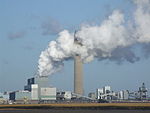Kingsnorth power station

Kingsnorth power station was a dual-fired coal and oil power station on the Hoo Peninsula at Medway in Kent, South East England. The four-unit station was operated by energy firm E.ON UK, and had a generating capacity of 2,000 megawatts. It was capable of operating on either coal or oil, though in practice oil was used only as a secondary fuel or for startup. It was also capable of co-firing biofuel, up to a maximum of 10% of the station's fuel mix. A replacement power station, also coal-fired, was considered by owners E.ON, but plans were abandoned. The proposed replacement attracted substantial public protests and criticism, including the 2008 Camp for Climate Action.
Excerpt from the Wikipedia article Kingsnorth power station (License: CC BY-SA 3.0, Authors, Images).Kingsnorth power station
Jacobs Lane,
Geographical coordinates (GPS) Address Nearby Places Show on map
Geographical coordinates (GPS)
| Latitude | Longitude |
|---|---|
| N 51.418947 ° | E 0.602702 ° |
Address
Jacobs Lane
ME3 9NQ , Hoo St. Werburgh
England, United Kingdom
Open on Google Maps








